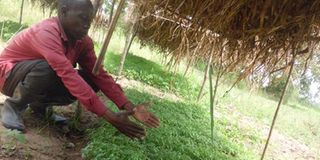From a clerical officer to mixed farmer

Okecho tends to tomato seedlings. PHOTO BY LOMINDA AFEDRARU
What you need to know:
Most farmers in Uganda use rudimentary methods where they do not apply the often necessary agricultural inputs such as fertilisers. However, this trend is gradually changing with a number of them embracing certain farm practices such as irrigation, seed beds and fertilisers. One such farmer is Esau Okecho, a mixed farmer in Tororo. He shared his story with Lominda Afedraru.
My name is Esau Misinde Okecho, 55, a mixed farmer in Pabona village in Luala Sub-county, Tororo District. I carry out mixed farming on our family land, which is about 50 acres. Out of this, I use 10 acres while the rest of the land is used by other family members.
I actually started farming at a younger age with my parents. After completing O- Level in 1982, I moved to Kampala to work at the Ministry of Housing and Urban Development as a clerical officer.
This was until I was retrenched in the first phase of the civil service retrenchment exercise in 1992.
However, while I worked in Kampala, I occasionally visited the village because I got a wife in 1989 when my father passed on. Since I was the elder son, it was my responsibility to ensure that our land is utilised properly.
Full-time farmer
After being retrenched, I tried to gamble with life in the city. Eventually, I came back to the village to become a full-time farmer.
I grow various food crops such as maize, millet, groundnuts, cassava and sorghum for both domestic consumption and commercial purposes.
There are also vegetables such as tomatoes as well as fruits. In addition, I practise beekeeping.
Most of the labour is mainly family members. I have two wives now and 10 children—six of them are in secondary school. It is from the proceeds from the farm that I pay school fees and related costs, and meet other family needs.
Encouragement
Currently, it is from horticulture where I seem to be earning better income. I have tomato seedlings at the nursery bed where I am waiting for the rainy season to start planting.
I prefer to concentrate on this activity during rainy season although the earnings from vegetables during dry season are much higher. However, sometimes, prolonged dry spells can be a challenge.
What I usually do is that I purchase the tomato seed from Tororo District Farmers Association (Todfa) input stores.
The agronomists there encourage us, the farmers, to purchase clean planting seeds from them. This is so as to avoid the likelihood of purchasing fake seed from unscrupulous dealers, which will fail to germinate.
In working on seedlings, I do not follow the procedure where other nursery bed operators plant the seedlings in a polythene pot because it is tedious.
What many farmers usually do is to plant the seeds in lines with a spacing of six inches.
I learnt this from the agricultural show in Jinja, which we attended with the encouragement and support from Todfa.
It takes one month for the seeds to germinate and grow before transplanting them to the field.
Various activities
I have been doing horticulture for three years. I started it with about capital of Shs50,000 including the purchase of seed and labour. For instance, two tins of tomato seed cost Shs25,000, a tin of sukuma wiki seed is sold at Shs8,000 and hybrid cabbage seed goes at Shs20,000 all measured in 10 grams.
This season, I am going to plant tomatoes on two acres. My major aim is to specialise in commercial tomato growing. The rest of the vegetables will be planted for home consumption.
I have tried to make everything less expensive by planting Napier grass whose stalks I use to support the tomato plants.
I chop the leaves as fodder for my heifer cow, which was given to me under the Naads [National Agricultural Advisory Service] programme.
There is a water source, which is about 50 metres from the farm. I am in the process of laying water pipes to enable irrigation.
I am a beekeeper as well. In my apiary, I have more than 20 beehives, which are Kenya Top Bar (KTB) and Langstroth types. The latter has chambers where one can divide the colony and transfer it to an empty beehive with a queen. This is for purposes of multiplying the number of bees with their queen.
I market the honey through Tororo District Beekeeping Farmers Association. Sometimes, we bulk our production for better price negotiation through our village beekeeping association. It is called Nyapyago Bee Farmers Association.
Good practices
Another activity that I am actively involved in is growing hybrid mangoes. I have 200 mango trees, from which I have started to harvest fruits. There is a challenge of the pests, which destroy the fruits and flowers.
I am able to carry out these activities working alongside and with support of technical personnel at Todfa. They usually come on ground to sensitise us about good agronomic practices.
I am glad that Todfa is partnering with Usaid Tetratech programme. Through this, the farmers are linked to purchase genuine inputs from the right agro-inputs dealers.
This is because we have challenges of pests and diseases, and long dry spells.
On my farm, there is a bushy area, which is close to the swamp where I get water to irrigate the vegetables.
Tsetse flies breed in this place, which leads to our livestock being infected with Nagana. But, I am now clearing the bush to get rid of the tsetse flies.
Another challenge the farmers face is to access ox ploughs, which are owned by very few farmers. So, we hire from those who have. This means we cannot plough our lands at the same time.




